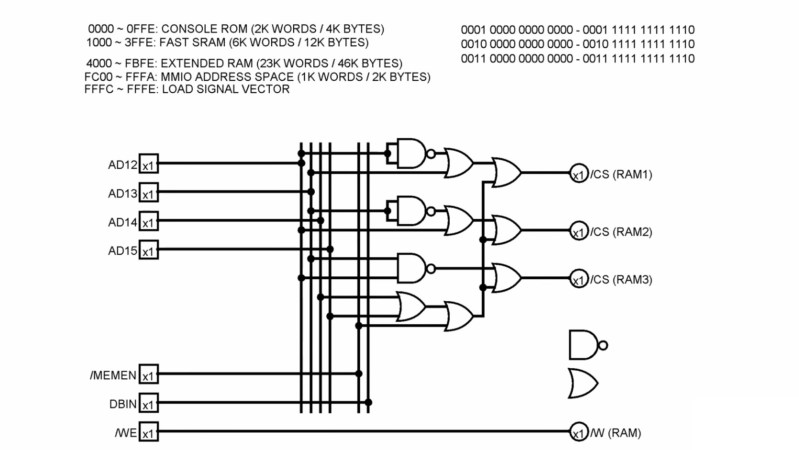Over on YouTube [Usagi Electric] shows us how to make RAM for the TMS9900.
He starts by remarking that the TI-99/4A computer is an excellent place to start if you’re interested in getting into retro-computing. Particularly there are a lot of great resources online, including arcadeshopper.com and the AtariAge forums.
The CPU in the TI-99 is the TMS9900. As [Usagi Electric] explains in the video this CPU only has a few registers and most actual “registers” are actually locations in RAM. Because of this you can’t do much with a TMS9900 without RAM attached. So he sets about making some RAM for his homebrew TMS9900 board. He uses Mitsubishi M58725P 16 kilobit (2 kilobyte) static RAM integrated circuits; each has 11 address lines and 8 data lines, so by putting two side-by-side we get support for 16-bit words. Using six M58725Ps, in three pairs, we get 6 kilowords (12 kilobytes).
He builds out his RAM boards by adding 74LS00 Quad 2-input NAND gates and 74LS32 Quad 2-input OR gates. Anticipating the question as to why he uses NAND gates and OR gates he explains that he uses these because he has lots of them! Hard to fault that logic. (See what we did there?)
After a quick introduction to the various animals in his household [Usagi Electric] spends the rest of the video assembling and testing his RAM. For testing the RAM with full feature coverage a simple assembly program is written and then compiled with a custom tool chain built around a bunch of software available on the internet. Success is claimed when the expected trace is seen on the oscilloscope.
Of course we’ve seen plenty of TMS9900 builds before, such as with this TMS9900 Retro Build.
















I like the way he builds the system step by step on small boards. Very educational. But I can’t stop wondering when the limitations will hit. The TMS9900 is a dynamic processor, and I don’t think it will take well with loose timings.
The TI99/4 developers could have made a shared-memory system approach with the video ram, but didn’t do that. Did they try and fail, or did they choose the design that they did on purpose for cost saving?
The chip the TI-99/4 was designed for wasn’t ready, and there was a deadline, so they shoved the TMS9900 in there and bodged everything to make it work on time.
The TMS9900 was a very poor choice for a home computer.
What chip was the TI-99/4 designed for?
The original design was all 8-bit, and based on TI’s version of the 8080. Of course that was unacceptable so they were going to use the TMS-9995 (faster, cheaper, no external register etc). That wasn’t ready so they used the TMS-9900 instead. Wouldn’t have fixed the design much, but anyway.
The TMS-9995 was used in later models (99/2, 99/8) but they were never released,
TMS9900 was designed for mini computers, similar to the PDP-11. When TI shoehorned it into a personal computer, they severely restricted the performance. That was the same CPU that was used in some business computers.
LS138?
I’m delighted that the TMS9900 CPU is experiencing kind of a renaissance! As a student in the early 80s at the Institute for Electroacoustics of the Technical University of Munich, my task was to design and build various circuit boards (RAM, interfaces, CPU board, digital-to-analog converters, etc.). They were boards in Eurocard format (160x100mm) with 64-pin connectors according to DIN41612 and a backplane. The whole thing was installed in a 19″ chassis. These computers were used for psychoacoustic research, including masking effects – my “boss” later became a co-developer of mp3…
Together with the units we built privately, about 30 complete systems were built!
We also developed a CPU board with the successor TMS9995, but despite the higher speed, it wasn’t usable for the research work: the generated sound had strange distortions. The cause turned out to be that due to the more modern design of the CPU with an instruction pipeline, the execution times of the instructions were no longer constant.